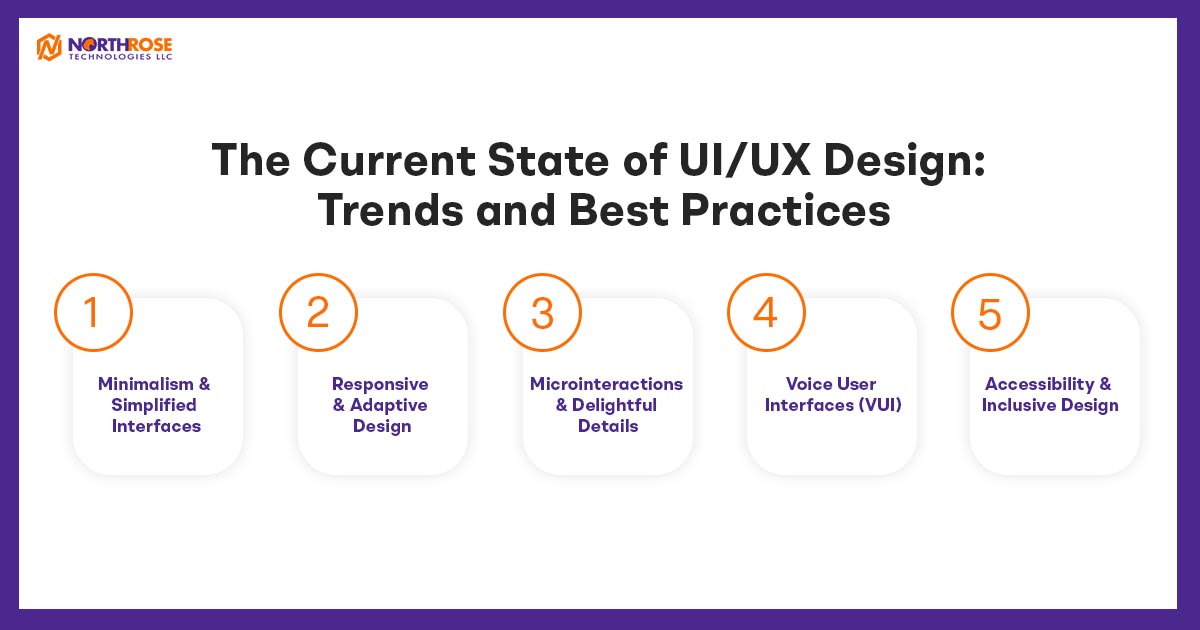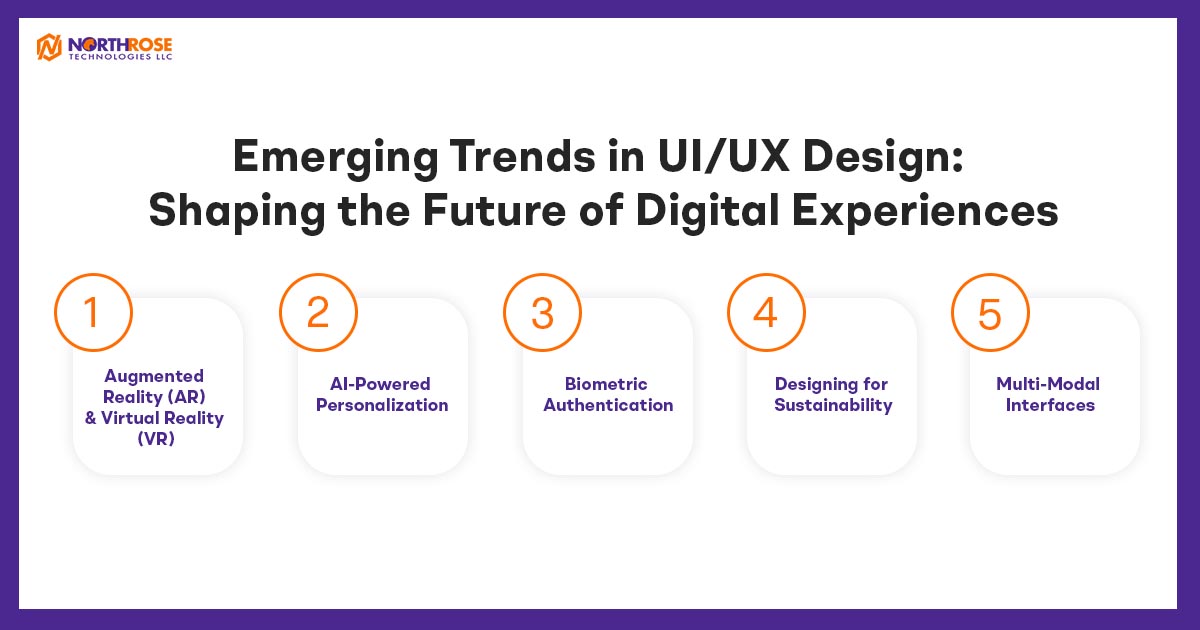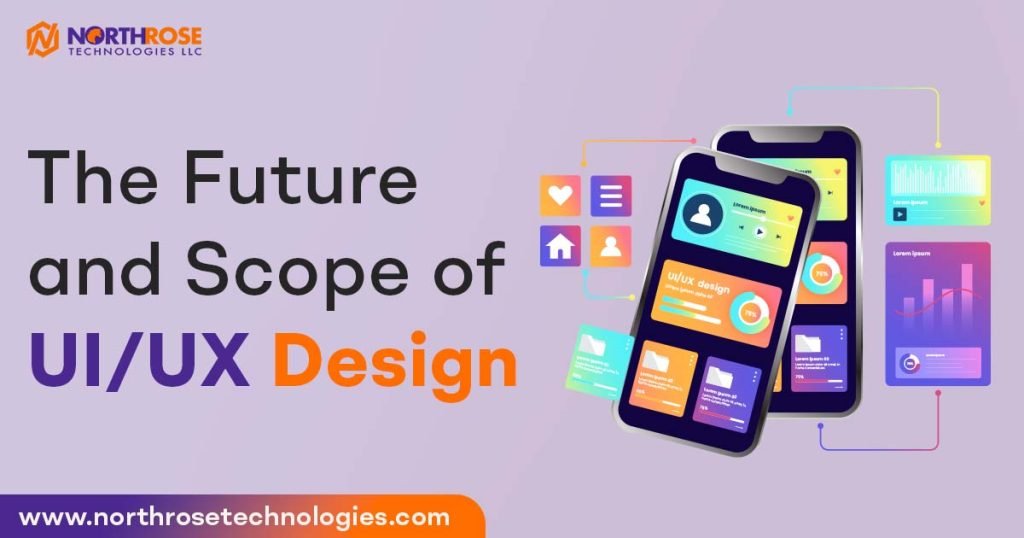User Interface (UI) and User Experience (UX) design have become essential areas in the rapidly changing world of digital experiences, contributing to the success of goods and services.
For companies looking to stay competitive and relevant in the digital space, the future and extent of UI/UX design are becoming more and more important as technology develops and consumer expectations change.
Understanding UI Design
All of the visual components of a digital product that consumers interact with, including buttons, icons, typography, and color schemes, are the focus of user interface (UI) design.
Making user interfaces that are aesthetically beautiful and intuitive is the main objective of UI design to increase user pleasure and engagement.
Key principles of UI design include:
- Visual Hierarchy: Organizing elements on the interface to guide users’ attention and streamline navigation.
- Consistency: Maintaining uniformity in design elements throughout the product to provide a cohesive user experience.
- Feedback: Providing users with immediate feedback to confirm their actions and enhance usability.
- Accessibility: Ensuring that the interface is accessible to users with disabilities, adhering to web accessibility standards such as WCAG (Web Content Accessibility Guidelines).
UX Design: Crafting Seamless User Experiences
The discipline of User Experience (UX) design is concerned with the complete experience that arises from interacting with a product or service. This includes aspects such as usability, accessibility, and emotional involvement.
UX design is concerned with the whole user journey, from the moment a user lands on a website or opens an app until they complete their task. This is in contrast to UI design, which is primarily concerned with visual aesthetics.
Key principles of UX design include:
- User Research: Researching to understand users’ needs, behaviors, and pain points to inform design decisions.
- Information Architecture: Organizing content and features in a way that facilitates intuitive navigation and findability.
- Prototyping and Testing: Iteratively designing and testing prototypes to gather feedback and refine the user experience.
- Continuous Improvement: Monitoring user feedback and analytics to identify areas for improvement and optimization.
The Current State of UI/UX Design: Trends and Best Practices
As technology continues to advance at a rapid pace, the field of UI/UX design is constantly evolving to meet the changing needs and expectations of users. Below we highlight key UI/UX design trends and best practices currently shaping the industry.

1) Minimalism and Simplified Interfaces
A shift towards minimalist website design aesthetics has been observed in recent years, with many designers choosing to focus on information and functionality through simple, clutter-free interfaces. In addition to improving visual appeal, minimalism reduces cognitive overload and facilitates users’ ability to concentrate on important tasks, which increases usefulness.
2) Responsive and Adaptive Design
As smartphones, tablets, and other devices become more prevalent it is essential to design for a variety of screen sizes and resolutions. Designers can create interfaces that fluidly adjust to different screen orientations and devices by utilizing responsive and adaptive design strategies, guaranteeing a consistent user experience on all platforms.
3) Microinteractions and Delightful Details
Subtle actions, sounds, or visual cues that improve user experience and offer feedback are called micro-interactions. Small elements like the pleasing tone of a notification or the soft bounce of a button can add to the overall user happiness of an interaction by making it feel more engaging and clear.
4) Voice User Interfaces (VUI) and Conversational Design
Voice user interfaces (VUI) and conversational design are becoming more and more popular as voice-controlled assistants such as Siri, Alexa, and Google Assistant become more common. Designing for VUI requires a very distinct approach, focusing on natural language processing, speech recognition, and conversational flow to create intuitive and engaging voice interactions.
5) Accessibility and Inclusive Design
Making digital products and services accessible to people with different abilities is crucial as they become more and more integrated into daily life. Designing products that are usable by the largest possible audience—including individuals with disabilities—is encouraged by inclusive design principles. This covers things like keyboard navigation, screen reader compatibility, and alternative text for images.
Emerging Trends in UI/UX Design: Shaping the Future of Digital Experiences
While the current state of UI/UX design is characterized by ongoing innovation and refinement, several emerging trends are poised to shape the future of digital experiences in profound ways.

1) Augmented Reality (AR) and Virtual Reality (VR)
Technologies like virtual reality (VR) and augmented reality (AR) have the power to completely change how people interact with computer interfaces and obfuscate the distinction between the real and virtual worlds. AR and VR have countless opportunities for developing rich, engaging user experiences, ranging from virtual collaboration tools to immersive retail experiences.
2) AI-Powered Personalization
User experiences are becoming more and more personalized because of the application of artificial intelligence (AI) and machine learning algorithms, which are based on unique tastes, behaviors, and demographics. Designers can create customized experiences that connect with customers more deeply with the help of AI-powered personalization. This can be used for everything, from dynamic content delivery to personalized product suggestions.
3) Biometric Authentication and Gesture-Based Interfaces
Digital interfaces are increasingly using biometric authentication techniques such as fingerprint, face, and iris scanning, which provide a more convenient and safe option than conventional password-based authentication. Additionally gaining popularity are gesture-based interfaces, which let users engage with gadgets through movements and actions, especially in the context of touchless interactions.
4) Designing for Sustainability and Ethical Considerations
The increasing consciousness of environmental and social concerns has led to a greater focus on creating digital products and services that are both ethically and sustainably designed. From reducing energy consumption to promoting inclusivity and diversity, designers have a crucial role to play in advancing sustainability and ethical considerations in UI/UX design.
5) Multi-Modal Interfaces and Cross-Platform Experiences
The rising prevalence of smart devices and Internet of Things (IoT) technology has led to consumers interacting with digital interfaces using a variety of modalities, such as touch, gesture, and speech. UI/UX designers face opportunities as well as obstacles when creating smooth, cross-platform experiences that switch between several modalities.
Challenges and Opportunities in the Future of UI/UX Design
While the future of UI/UX design is filled with promise and potential, it also presents a unique set of challenges and opportunities for designers.
1) Balancing Innovation with Accessibility
Designers must continue to push the envelope of creativity and innovation while making sure digital interfaces are usable by people of all abilities. Designers also have to embrace inclusive design principles and take into account the varied needs and preferences of users at every stage of the design process to strike a balance between creativity and accessibility.
2) Data Privacy and Security Concerns
Data security and privacy concerns are growing as digital products and services become more tailored and data-driven. To gain consumers’ trust and confidence, designers must put user data protection first and include privacy-enhancing features in their designs.
3) Designing for Emotional Engagement
While usability and functionality are essential aspects of UX design, designing for emotional engagement presents a unique challenge for designers. A profound understanding of human psychology and emotional design principles is necessary to create experiences that elicit positive feelings such as joy, delight, and empathy.
1) Bridging the Gap Between Physical and Digital Experiences
An increasing number of people are realizing the need to bridge the gap between digital and physical experiences as digital interfaces become more and more integrated into everyday life. For UI/UX designers, creating seamless, integrated experiences that smoothly move between the real and virtual worlds offers both opportunities and challenges.
2) Lifelong Learning and Skill Development
In a rapidly evolving field like UI/UX design, lifelong learning and skill development are essential for staying abreast of emerging trends and technologies. Designers must continually update their skill sets and stay curious and adaptable to remain competitive in the ever-changing landscape of digital design.
In conclusion, the future and scope of UI/UX design are characterized by innovation, evolution, and endless possibilities.
As technology continues to advance and user expectations evolve, UI/UX designers have a crucial role to play in shaping the digital experiences of tomorrow.
To make your UI/UX easier and more productive, connect with North Rose Technologies for their expert services.




